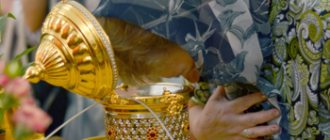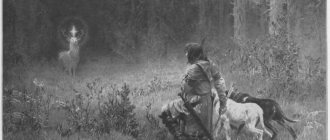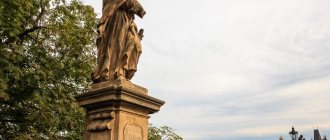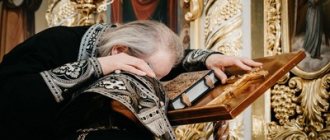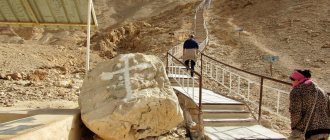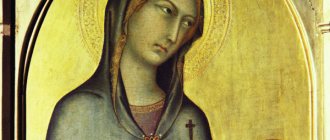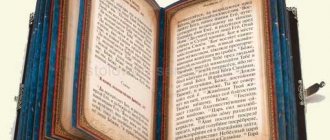Relics
According to various sources, the version of the origin of the image arose in the period from the 13th to the 15th centuries. among the Franciscan monks. The pious Jewish woman Veronica, who accompanied Christ on His way of the cross to Calvary, gave Him a linen handkerchief so that Christ could wipe the blood and sweat from his face. The face of Jesus was imprinted on the handkerchief. Presumably, the name Veronica, when mentioning the Image Not Made by Hands, arose as a distortion of the Latin expression vera icon (true image).
In Western iconography, a distinctive feature of the “Plate of Veronica” images is the crown of thorns on the head of the Savior.
The now abolished constellation was once named in honor of the “Plate of Berenices”.
Relics have been preserved, the authenticity of which the church considers possible.
1. One of the relics, called “Veronica’s boards,” is kept in the Cathedral of St. Peter's in Rome. This is a thin fabric in which the image of the Face of Jesus Christ can be seen in the light. The Vatican calls the Plata Veronica the most valuable relic of Christianity, which is kept in St. Peter's Basilica. In 1628, Pope Urban VIII issued a ban on the public display of the board, and since then Veronica's board has been removed from the column for public viewing only once a year - on the fifth Sunday supper of Lent, but the display time is limited and it is shown from the high loggia of the Pillar of Saint Veronica . Only canons of St. Peter's Basilica are allowed to approach the relic.
2. Another relic, a plate from Manopello, is kept in the cathedral of a small village in the province of Abruzzo. The German Jesuit priest, art teacher at the Gregorian University in Rome, Frank Heinrich Feiffer, studying the board, came to the conclusion that it has unusual, one might say supernatural properties. The veil is a small piece of fabric measuring 6.7 by 9.4 inches (approximately 17 by 24 cm). It is almost transparent, reddish-brown in color, the face of a bearded man is imprinted on it, there are no traces of paint on it. Depending on the inclination of the sun's rays, the face either disappears or appears, which in the Middle Ages was considered a miracle in itself. In addition, the image is on both sides - both are absolutely identical to each other. The relic is a mixture of a transparency and a hologram. It shows the face of a Mediterranean-looking man with a broken face and a broken nose. Details like the thin beard and plucked eyebrows almost look like a photograph, or at least a negative. In dim lighting, the image loses color, the prints become darker and the facial features of Christ look like those of a deceased person. If you turn the image against the daylight, it disappears, and when you observe it from the side of the altar, the expression of the eyes on the face of Jesus changes, and he seems to be looking to the side. The veil is made of fine linen. Many researchers are inclined to believe that this particular board is genuine due to the extraordinary quality of the image, similar only to the Shroud of Turin.
3. Another relic - a rectangular piece of linen cambric. Blood stains are preserved on the canvas, and the features of the Holy Face of Jesus Christ are depicted (iconographically). The plate is kept in the Spanish city of Alicante in the Monastery of the Holy Face (El Monasterio de Santa Verónica / de Santa Faz), which is located 5 km from the city, along the highway, towards Valencia. The monastery was built in 1766. There is also a fortress tower from the 16th century. Every year in May, more than 50,000 pilgrims with staffs decorated with sprigs of rosemary come to the monastery on the Feast of the Holy Face (Santa Faz) to pay homage to the canvas with the Holy Face of Jesus Christ, brought to Alicante from Rome in 1489.
crown of thorns
The crown of thorns is a crown of plant branches with thorns, which, according to the Gospels, was placed on the head of Jesus Christ by Roman soldiers during His reproach. Today, the relic, revered as the Crown of Thorns of God, is located in Paris, in the Cathedral of Notre Dame de Paris. Despite numerous studies, the authenticity of the crown could not be proven. The relic is displayed on every first Friday of the month, Good Friday, and every Friday of Lent.[5]
crown of thorns
Similar images
The canonical Gospels do not directly describe the appearance of any of the images. In non-canonical sources, in addition to the plate of Saint Veronica, two more miraculous images of Jesus Christ are named:
Face from Edessa (Savior Wet Brad, Savior Not Made by Hands)
According to Syrian sources of the 4th century, the miraculous image of Christ, later called the Mandylion, was captured for the king of Edessa (Mesopotamia, modern Sanliurfa, Turkey) Abgar V Ukkama by an artist sent by him; Christ washed his face, wiped it with a cloth (ubrus), on which an imprint remained, and handed it to the artist. The characteristic features of the Face of Edessa are that Jesus Christ wiped his wet face with a towel after washing, so His hair and beard were wet and divided into three strands: two strands of wet hair and one strand of wet beard. The Face of Edessa is also called the Savior of Wet Brad.
Thus, according to legend, the Mandylion became the first icon in history. A linen cloth with the image of Christ was kept in Edessa for a long time as the most important treasure of the city. During the period of iconoclasm, John of Damascus referred to the Image Not Made by Hands, and in 787 the Seventh Ecumenical Council cited it as the most important evidence in favor of icon veneration. On August 29, 944, the image was purchased from Edessa by Emperor Constantine VII Porphyrogenitus and solemnly transferred to Constantinople; this day was included in the church calendar as a holiday.
The relic was stolen from Constantinople during the sack of the city by participants in the IV Crusade in 1204, and lost (according to legend, the ship carrying the icon was wrecked).
Shroud of Turin
Shroud of Turin. On the preserved canvas, in which, according to legend, the body of the Lord taken from the cross was wrapped, and which Joseph of Arimathea preserved, puncture marks from thorn needles and blood stains were preserved. The Shroud is kept in Turin (Italy).
Life-giving Cross
The Life-Giving Cross is the cross on which, according to Christian beliefs, Jesus Christ was crucified. It is one of the main Christian relics. According to legend, the cross was found by Queen Helena, the mother of the Roman Emperor Constantine I, in 326. She ordered the destruction of the temple built on the site of Christ's crucifixion and the excavation of three crosses - one - the blessed one, on which Christ hung, and the other two, on which the robbers were crucified. According to legend, in order to determine which cross Jesus was crucified on, all three crosses were brought to a terminally ill woman, who recovered as soon as she touched the Life-Giving Cross.
Over the course of its history, the tree of the Life-Giving Cross was divided into particles of different sizes, which can now be found in many churches and monasteries around the world. According to a study conducted in the 19th century, the total weight of all documented fragments of the Cross is only about 1.7 kg.[1][2][3]
The largest known part of the Life-Giving Cross (Church of the Holy Sepulchre)
Literature
- Belting H.
Image and cult: the history of the image before the era of art. M., 2002. S. 237-238, 248-256, 601-604 - Seeing Salvation
. Images of Christ in Art. Neil MacGregor, ISBN 0-563-55111-9
| Personalities | Jesus Christ • Mother of God • Mary Magdalene • Mary of Cleopas • Joseph of Arimathea • Nicodemus • John the Theologian • thieves • people • Sanhedrin • Centurion Longinus • resurrected saints • Guard at the tomb |
| Places | Golgotha • Pilate's Praetorium • Stone of Anointing • Holy Sepulcher • • Zion's Upper Room |
| Items | Instruments of the Passion: Life-Giving Cross • Veronica's Plath • Shroud of Christ • Sudar • Myrrh • Crown of Thorns • Spear of Longinus • Nails of the Holy Cross • Purple of Christ |
| Iconography | Christ in the Tomb • Man of Sorrows • Weep Not Me, Mother • Shroud • Pietà |
Nails
While believers around the world debate whether three or four nails were needed to crucify Jesus Christ, there are already at least 30 such relics in the world. According to legend, the nails were found by the same Queen Helen during the excavation of the Life-Giving Cross. She gave some of the nails to her son Constantine I, who used them to create a royal diadem and a bridle for his horse. It is rumored that one of the nails was used to create the Iron Crown, which is kept in the Temple of John the Baptist in Italy.[7][8]
Iron crown with a Holy nail inside
An excerpt characterizing Veronica's Plath
After his explanation with his wife, Pierre went to St. Petersburg. In Torzhok there were no horses at the station, or the caretaker did not want them. Pierre had to wait. Without undressing, he lay down on a leather sofa in front of a round table, put his big feet in warm boots on this table and thought. – Will you order the suitcases to be brought in? Make the bed, would you like some tea? – asked the valet. Pierre did not answer because he did not hear or see anything. He began to think at the last station and continued to think about the same thing - about something so important that he did not pay any attention to what was happening around him. Not only was he not interested in the fact that he would arrive in St. Petersburg later or earlier, or whether he would or would not have a place to rest at this station, but it was still in comparison with the thoughts that occupied him now whether he would stay for a few days. hours or a lifetime at this station. The caretaker, the caretaker, the valet, the woman with Torzhkov sewing came into the room, offering their services. Pierre, without changing his position with his legs raised, looked at them through his glasses, and did not understand what they could need and how they could all live without resolving the questions that occupied him. And he was preoccupied with the same questions from the very day he returned from Sokolniki after the duel and spent the first, painful, sleepless night; only now, in the solitude of the journey, did they take possession of him with special power. No matter what he started to think about, he returned to the same questions that he could not solve, and could not stop asking himself. It was as if the main screw on which his whole life was held had turned in his head. The screw did not go in further, did not go out, but spun, not grabbing anything, still on the same groove, and it was impossible to stop turning it. The caretaker came in and humbly began to ask His Excellency to wait only two hours, after which he would give courier for His Excellency (what will happen, will happen). The caretaker was obviously lying and only wanted to get extra money from the passerby. “Was it bad or good?” Pierre asked himself. “For me it’s good, for another person passing through it’s bad, but for him it’s inevitable, because he has nothing to eat: he said that an officer beat him for this. And the officer nailed him because he needed to go faster. And I shot at Dolokhov because I considered myself insulted, and Louis XVI was executed because he was considered a criminal, and a year later they killed those who executed him, also for something. What's wrong? What well? What should you love, what should you hate? Why live, and what am I? What is life, what is death? What force controls everything?” he asked himself. And there was no answer to any of these questions, except one, not a logical answer, not to these questions at all. This answer was: “If you die, everything will end. You’ll die and find out everything, or you’ll stop asking.” But it was also scary to die. The Torzhkov merchant offered her goods in a shrill voice, especially goat shoes. “I have hundreds of rubles that I have nowhere to put, and she stands in a torn fur coat and timidly looks at me,” thought Pierre. And why is this money needed? Can this money add exactly one hair to her happiness, peace of mind? Could anything in the world make her and me less susceptible to evil and death? Death, which will end everything and which should come today or tomorrow, is still in a moment, in comparison with eternity.” And he again pressed the screw that was not gripping anything, and the screw still turned in the same place. His servant handed him a book of the novel in letters to m m e Suza, cut in half. [Madame Suza.] He began to read about the suffering and virtuous struggle of some Amelie de Mansfeld. [Amalia Mansfeld] “And why did she fight against her seducer,” he thought, “when she loved him? God could not put into her soul aspirations that were contrary to His will. My ex-wife didn't fight and maybe she was right. Nothing has been found, Pierre told himself again, nothing has been invented. We can only know that we know nothing. And this is the highest degree of human wisdom." Everything in himself and around him seemed to him confusing, meaningless and disgusting. But in this very disgust for everything around him, Pierre found a kind of irritating pleasure. “I dare to ask your Excellency to make room for a little bit, for them,” said the caretaker, entering the room and leading behind him another traveler who had been stopped for lack of horses. The man passing by was a squat, broad-boned, yellow, wrinkled old man with gray overhanging eyebrows over shiny eyes of an indeterminate grayish color. Pierre took his feet off the table, stood up and lay down on the bed prepared for him, occasionally glancing at the newcomer, who with a sullenly tired look, without looking at Pierre, was heavily undressing with the help of a servant. Left in a worn-out sheepskin coat covered with nankin and in felt boots on thin, bony legs, the traveler sat down on the sofa, leaning his very large, short-cropped head, wide at the temples, against the back and looked at Bezukhy. The stern, intelligent and insightful expression of this look struck Pierre. He wanted to talk to the passerby, but when he was about to turn to him with a question about the road, the passerby had already closed his eyes and folded his wrinkled old hands, on the finger of one of which there was a large cast-iron ring with the image of Adam’s head, sat motionless, either resting, or about thinking deeply and calmly about something, as it seemed to Pierre. The traveler's servant was covered with wrinkles, also a yellow old man, without a mustache or beard, which apparently had not been shaved, and had never grown on him. A nimble old servant dismantled the cellar, prepared the tea table, and brought a boiling samovar. When everything was ready, the traveler opened his eyes, moved closer to the table and poured himself one glass of tea, poured another for the beardless old man and handed it to him. Pierre began to feel uneasy and necessary, and even inevitable, to enter into a conversation with this passing person.
Sir
Sir
Sudar (from Latin sudarium - “handkerchief for wiping sweat from the face”) - a handkerchief that was used to cover the head of Jesus Christ after death. There are no images on the material, but its surface has absorbed extensive blood stains. According to some studies, the blood stains on the sudar closely match the shape of the corresponding stains on the Shroud of Turin (see below), which may indicate that both materials covered the same body. The relic is kept in the Camara Santa Chapel of the Cathedral of San Salvador in Spain, and is displayed three times a year.[6]
Casket with the sir in Oviedo
Holy Grail
The Holy Grail is the cup from which Jesus Christ ate at the Last Supper and into which Joseph of Arimathea collected the blood from the wounds of the Savior crucified on the cross. Despite the titanic efforts of many generations of researchers, the Holy Grail was never found.
Conspiracy theorists claim that the word “grail” refers to the blood of Jesus’ descendants. According to other researchers, the Holy Grail may mean the breast of Mary Magdalene.[9]
Foreskin of Jesus Christ
If the Holy Grail is the most coveted relic, then the foreskin of Jesus is certainly the most unusual. The foreskin (or prepuce) is a product of the Circumcision of the Lord, or in simple words, part of the skin of Christ’s penis. Numerous monasteries and churches have declared and continue to declare that they have a sacred prepuce, and numerous miraculous properties are attributed to the relic itself. According to some reports, there are as many as 18 preputies in the world, but officially, the church does not recognize any of them.[10][11]
